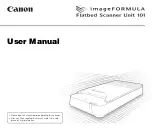
3-4
3.5 Using the Carrier Sheet
Use the carrier sheet according to the condition of the document to be scanned.
In the case of scanning the following types of media, always place the document in the carrier sheet
that is available as an option before loading it into the scanner.
• To scan a document that is smaller than A4 size or a document of non-standard size
• To scan a document that is as limp as or limper than a newspaper
• To scan a document that tears or becomes damaged easily
• To scan a document that is considerably damaged
• To scan a document that is badly creased
• To scan a curled document
• To scan a transparent or translucent document
• To scan a document to which other pieces of paper have been attached
• When the target document cannot be properly advanced to the initial position of scanning
(because the target document is not flat, or otherwise hard to load in the scanner)
• Curled documents with a width that exceeds A2-size (420 mm)
• Fragile documents with a width that exceeds A2-size (420 mm)
As shown in the figure below, place the document in the carrier sheet with the document’s
surface to be scanned face up (against the transparent top sheet). For scanning, load the
carrier sheet into the scanner with the document’s target surface (the transparent top sheet)
face up.
Insert in this direction
Insert in this direction
Transparent sheet (top surface)
Target document
(the surface to be scanned faces up)
White surface
(background surface)
C
heckpoint
• The carrier sheet is an option.
• When handling the carrier sheet, be very careful not to scratch or otherwise
damage it.
• If you use the carrier sheet when scanning color documents, the colors may shift
slightly in some cases.
















































